
If you’ve ever had someone laugh or look at you in disbelief when you tell them you’re going to make money as a YouTuber, you’re not alone.
Whether or not the people around you believe it, YouTube is now a very real career possibility – and some of the highest-paid YouTubers are making the same kind of money you could expect if you were a Hollywood A-lister, a supermodel, or a Premier League footballer.
Here, we’ll take a realistic look at how much money YouTubers make – from the superstars down to beginners. We’ll also answer plenty of questions and explore topics around making money on the platform, including:
- How much does YouTube pay?
- How to make money on YouTube
- How much do YouTubers make per view?
- What’s the average salary of a YouTuber?
We’ll also take a detailed look at some of the other ways that successful YouTubers and social media influencers make money from their online presence.
How do YouTubers make money?
You’re welcome to skip ahead and just look at the numbers if you’re just here to find out “how much does a YouTuber make?” – but if you’re curious to know how to make a living on YouTube, it’s useful to understand exactly how YouTube payments work.
Anyone can make a video and upload it to the platform – but it doesn’t mean you’re going to immediately start making an income.
So, how does YouTube monetisation work?
Well, all aspiring YouTubers need to join the YouTube Partner Program (YPP) – a service that gives video creators access to a world of useful resources and features. When you join YPP, you can get help from YouTube’s Creator Support team, you get tools that help with Copyright issues (helping you keep your content exclusive), and you can access to the platform’s monetisation features.

YouTube monetisation requirements
The rules around who can become part of the YPP are fairly broad. As the company that owns YouTube; Google explains that they don’t tell you what to create on the platform – but, since they have a responsibility to do what’s right by their viewers – they will hold you to a higher standard if you’re part of the Partner Program.
This starts when you apply to be part of YPP. Your channel will be reviewed before you’re accepted – then be subject to constant reviews thereafter. It’s not just the thumbs up from the channel review team you need either; you must also:
- Have at least 1,000 subscribers
- Reach 4,000 valid public watch hours in the past 12 months
- Sign and agree to the terms and conditions
- Have a Google AdSense account
From here, Google will decide which of its monetisation features you’ll be offered. These include:
- Advertising revenue: Getting you paid when display, overlay, or video ads appear on your channel or on your videos – the most common way to monetise your account and done through Google’s AdSense platform.
- Channel memberships: The opportunity to offer paid monthly memberships for special content or perks you might offer.
- Merchandise shelf: A mini online store that features on your watch pages that offers fans a chance to buy your products.
- Super Chat & Super Stickers: A chance for fans to pay to get their messages highlighted and special stickers to use in chat streams.
- YouTube Premier Revenue: Get a part of a Premium YouTuber’s subscription fee when they watch your content.
Each of these features has its own eligibility requirements:

Of course, there are just the official YouTube/Google monetisation routes you can explore – but there’s plenty of other options that we’ll dig into a little later too…
YouTube monetisation rates
Virtually all paid YouTubers start by making money from advertising revenue.
Now, people don’t have to be actually clicking on the adverts that appear on your videos or on your watch page – as this isn’t necessarily how companies pay Google’s AdSense service for advertising.
Sometimes, these adverts will be on a ‘pay per click’ basis (where the brand pays Google each time the advert is actually clicked) – but sometimes the company will be paying Google for ‘impressions’ (where they pay to have the advert simply shown to viewers).
As a YouTuber, if people are watching the adverts on your videos, you’ll start to get paid. If people click on the adverts, you’ll get paid even more.
To help consider what’s possible, we’ve used some average figures to put together a quick YouTube revenue calculator:
How much money per view on YouTube?
When Google gets paid, they pass on a big chunk of that AdSense revenue to the creator whose channel’s been used to display the advert. In fact, 68% of the money goes straight to you. Therefore, if the adverts on your videos and pages bring in £100 for YouTube, you’ll get £68 of that.
Since there are different ways for advertisers to pay, the exact amount Google charges varies – but it’s generally between £0.08 and £0.25 per view – with an average of around £0.16 per advert view.
What does that look like in real life – say for 1,000 video views?
Well, Let’s say an advertiser pays £0.16 per view – the money starts to look good.
The only problem is, not all of the people who watch the video will watch the adverts. It’s generally only around 15% that do – so out of 1,000 video views, you’re likely to get just 15% of those people watching the adverts – 150 people.
So, 150 advert views x £0.16 = £24 – and after YouTube takes their cut, you’ll end up with roughly £16 per 1,000 views.

Of course, these can only be considered rough figures – since there are so many variables. It’s also worth noting that you cannot get paid until you’ve generated at least £100 from views – so there’s no cashing out with a few pounds at a time.
Do YouTubers get paid for skipped ads?
As you can see, 1,000 video views don’t necessarily mean 1,000 advert views – and that’s because you can usually skip the adverts and jump straight into watching the video content.
That begs the question, do YouTubers get paid if you skip ads?
Generally, no – they don’t – but it depends on a few things.
If someone doesn’t view a full advert because they think it looks amazing and clicks on it before the end – then this is good news, because an advert click boosts the amount the YouTuber will get paid. On the other hand, if a viewer is impatient and closes or skips the ad before the end, the creator won’t get paid – as advertisers don’t pay for skipped ads.
With this in mind – you might want to think twice about skipping ads next time you’re watching your favourite YouTube channel!
Just watching adverts is one of the best ways to support a YouTuber.
Calculating YouTube payments exactly
It would be great to have a really simple calculation that explains how much you’ll get for every view you rack up when you’re part of the YPP – but there’s just no way of accurately calculating this – as there are so many variables.
Those variables include:
- Whether the adverts are actually being clicked
- If people are skipping or blocking adverts
- How relevant your video is to the advert
- The amount of competition to place adverts on your channel
- The type of audience your channel attracts
- The length and type of advertisement
It’s normal to wonder how much money 1,000 or 1 million views on YouTube will make – but with so many factors that can change the amount you’ll earn, we can only really work off industry averages.
Here's an example of how much you could earn with 50,000 daily views.
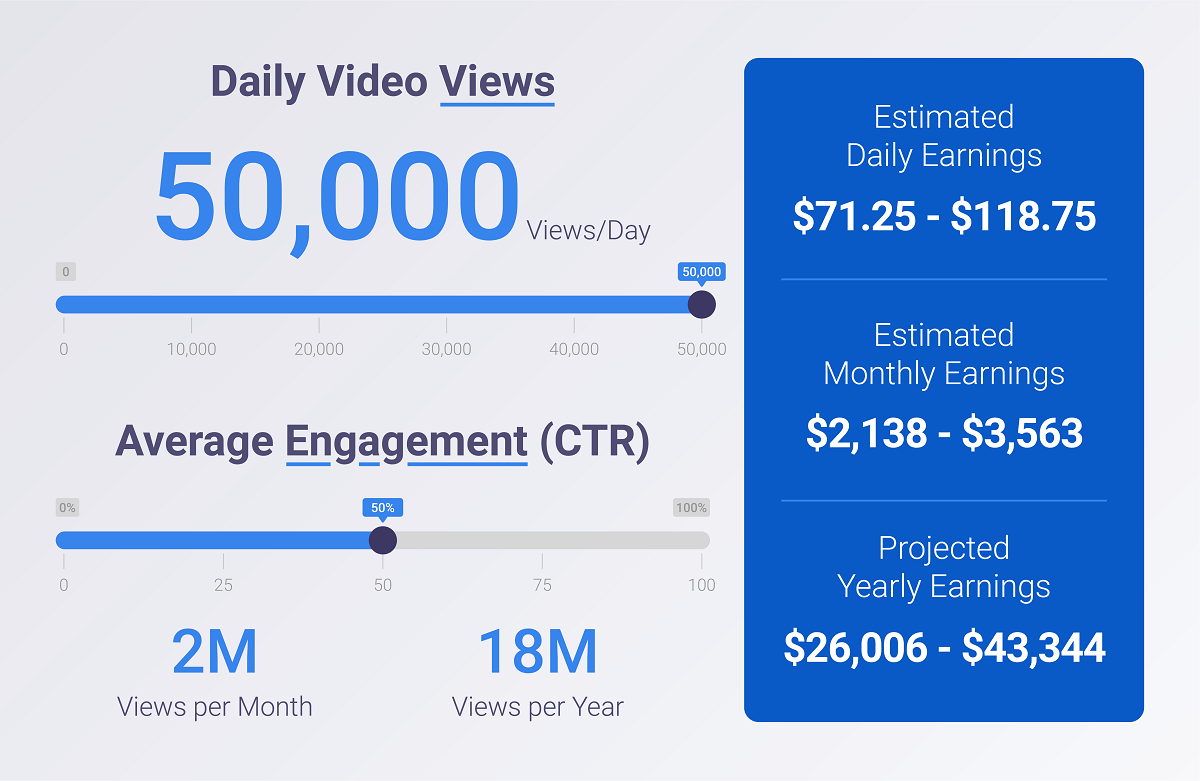
How many subscribers do you need to get paid?
If you’re wondering if YouTube pays you for subscribers as well as advert views – the answer is no – but that doesn’t mean that subscribers aren’t valuable.
Subscribers are vital if you want to get paid – and that’s because they’re your most faithful followers, and they can be the key to unlocking other ways to make money from YouTube.
Let’s start by considering what subscribers do to your viewing numbers:
When people hit that subscribe button, they do so because they like your content and they want to see more. They can even choose to be alerted when you publish new content. So, they might not get you paid directly – but subscribers can have a big impact on the number of people that watch your videos (and therefore watch adverts).
As well as boosting numbers of views, subscribers can help you to unlock alternative forms of YouTube income.
Remember that YPP table from earlier?
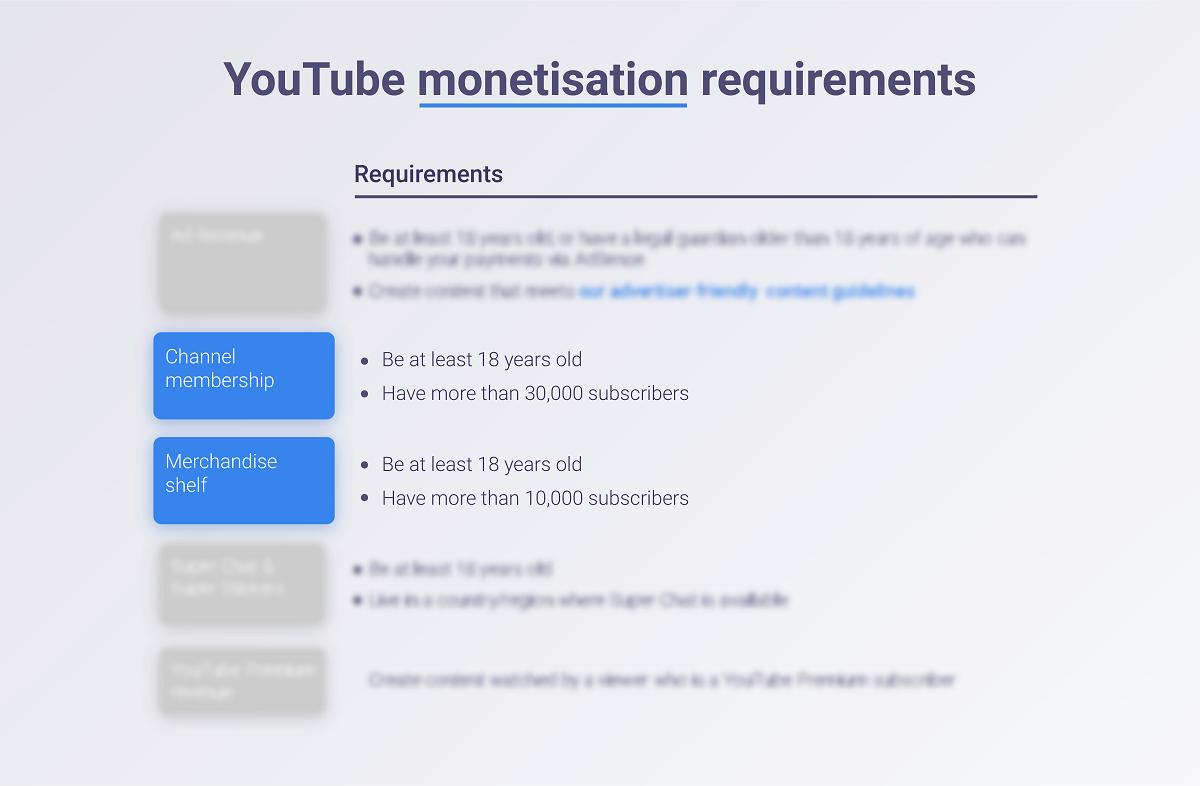
When you hit 10,000 and 30,000 subscribers, you unlock the Merchandise shelf first – then channel memberships.
What is a merchandise shelf?
A merchandise shelf is pretty much exactly what it says – a place for you to sell merch. There just over 20 different items that YouTube allow – from t-shirts and hats to phone cases and plushies.
The merch shelf is run in collaboration with Teespring – and it can be a great source of income. Teespring charge a set amount of their products – and you can choose to sell them for whatever you wish. Typically, a t-shirt’s cost price will be around £10 – but they generally sell for £20 and upwards.
You’ve probably seen the merchandise shelf on your favourite YouTubers channels:
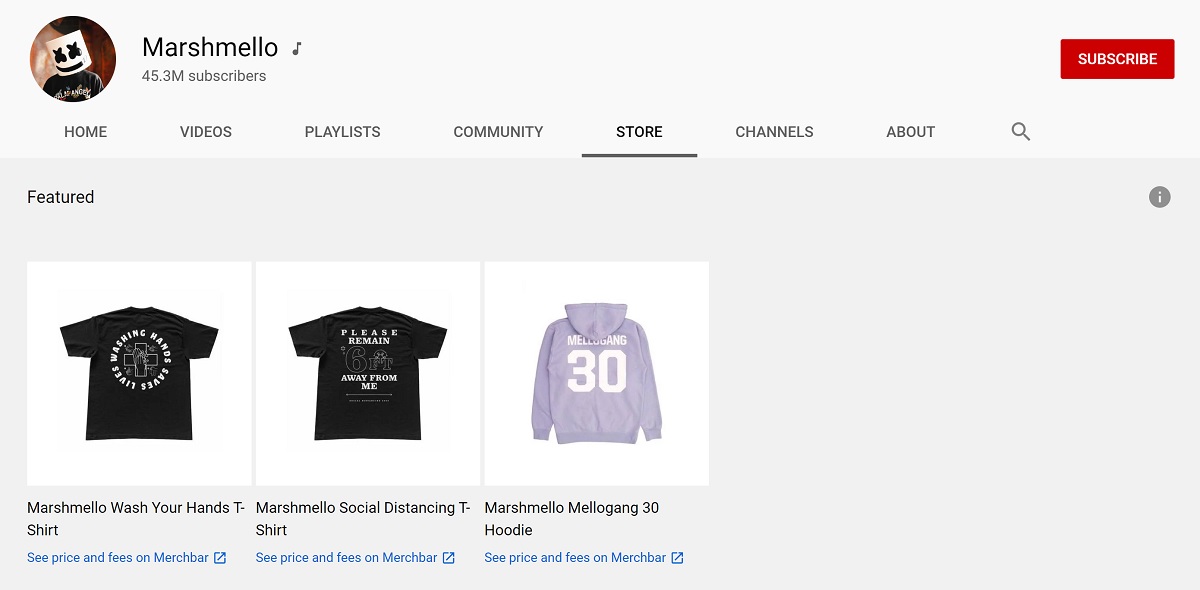
Since this can only be unlocked when you hit 10,000 subscribers, it’s proof that having dedicated followers can definitely boost your YouTube income.
What are channel memberships?
Now we’ve looked at what 10,000 subscribers unlocks – it’s worth looking at how can channel memberships help you to make a living on YouTube?
If you’re familiar with services like Patreon, you’ll recognise YouTube channel memberships as being very similar.
YouTube memberships are a way that fans can support their favourite creators. You’ll need 30,000 subscribers to unlock this feature – but when you do, you’ll get a ‘Join’ button that sits alongside the ‘Subscribe’ button under your videos:
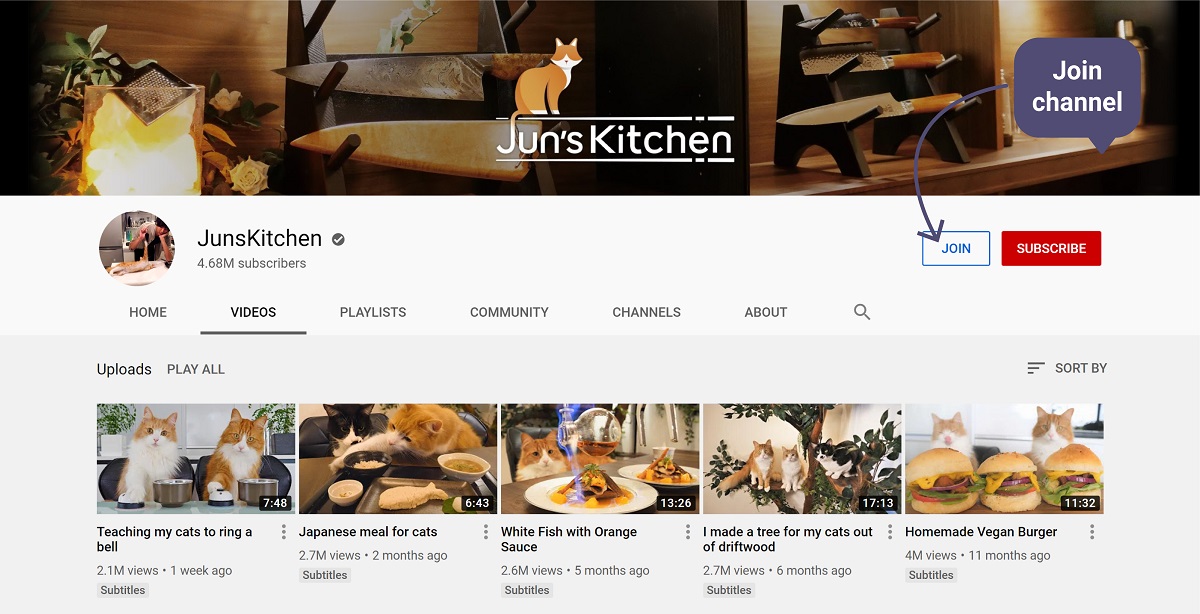
If someone decides to join your channel, they’ll pay at least £4.99 each month to access special perks that you offer. These things might be exclusive videos or live streams, and they’ll get an icon next to their name, identifying them as someone who financially supports your channel.
For every membership payment, the channel receives 70% of the funds – and YouTube takes 30%. Again, this is another great way to make an extra income from YouTube, while rewarding your fans at the same time.
What’s a realistic income for a new YouTuber?
So, we’ve covered plenty of income opportunities so far – but you’re new to the idea of using YouTube to create an income, you might be wondering how long will it take to get off the ground and how much can you expect to start earning?
Honestly, you’re unlikely to make anything as you get your channel up and running – but this is exactly the same for everyone.
You might not like that answer – but the key to making money on the platform is having an audience – and the key to having an audience is having great content and a solid reputation.
For lots of people, building a reputation happens off YouTube.
It might sound strange that having a good Instagram following will help you step into YouTube – but it’s all about growing an engaged audience that’s interesting in you.
It’s far easier to go from 0-1,000+ followers on Insta than it is to go from 0-1,000 subscribers on YouTube – and since the Influize team can help you build amazing engaged audiences on Instagram, it makes a lot of sense to establish yourself as an authority in your niche first – before you step into the world of YouTube video and bring that big, engaged audience with you.
So, how much can you expect to make in your early day? Not much – but this is the time to identify your niche, work on your technical skills, research what people are watching, and start building an engaged audience.
Growing your audience, views, and earnings
Across all industries and areas, average earnings in the UK are around £30,000 – so how many views or subscribers would you need to bring this kind of money home working as a YouTube influencer?
If we assume that a rough average is still £16 for 1,000 views, you’re going to need to rack up roughly 1.9 million views across the year if you want to earn the average UK wage as a YouTuber.
That might sound like a lot – but most YouTubers create and publish content every day – and even with a couple of holidays, that means you’d only need roughly 5,500 views on each video to start making YouTube look like a real career possibility. What’s more, this is just considering ad revenue – that’s before you look at other income streams from YouTube or other ways of monetising your content.
The amount of money you need to commit full-time hours to YouTube will depend on you – but when you’ve built a good niche audience that’s interested in what you do, you might find that hitting this number of daily views happens faster than you expect.
Making it as a YouTuber
Again, everyone’s idea of success is a little different – for some people, just being able to escape the rat-race and make a comfortable income on YouTube is a dream-come-true – but for others, big paydays are the name of the game.
So, let’s aim big and think about earning £250,000 before tax as a YouTuber – that’s over twice what a specialist NHS consultant or corporate lawyer might expect to bring in each year.
If we assume you’re going to create and promote a video almost every day, you’ll need to be aiming for 50,000 views on each of those – along with some merch sales and channel memberships. Is this going to be hard work? Definitely. Is it going to take a long time to get here? Almost certainly – but the important thing to remember is that it is possible.
There are people shooting video right now who never dreamed they would be making tens of thousands of pounds doing something they love and getting paid Hollywood wages for doing it – so you’re not being unrealistic to think you could get here – you just need to put in a lot of hard work and focus on building an interested audience.
How much do top YouTubers make per video?
Now we’ve covered a bit of info on how much YouTube ads pay and some of the other ways you can use YouTube to make money – let’s take a look at the people who are really killing it on the platform.
The highest-paid YouTubers of 2019
- Ryan Kaji - $26 million / £21 million
- Dude Perfect - $20 million / £16 million
- Anastasia Radzinskaya - $18 million / £15 million
- Rhett and Link - $17.5 million / £14.5 million
- Jeffree Star - $17 million / £14 million
- Preston - $14 million / £11 million
- PewDiePie - $13 million / £10.5 million
- Markiplier - $13 million / £10.5 million
- DanTDM - $12 million / £10 million
- VanossGaming - $11.5 million / £9.5 million
There’s a real mix of content in here too – Ryan Kaji is an 8-year old who reviews and plays with toys, whereas the Dude Perfect team is a group of guys in their 30s who are regularly breaking world records and shooting basketball trick shots.
As we’ve already mentioned, most professional top-tier YouTubers will be putting out a new video at least once every day and this is why they have the most subscribers on YouTube – which means their per-video-income will be between £25,000 and £58,000. Now, that doesn’t mean that just filming a video and putting it up means money in the bank – they too will have to make sure they’re making the most of the different YPP features and doing plenty of promotion on different platforms.
Of course, this is just a very small handful of the people who are making money on YouTube – and while there are some niches and industries that produce superstars like these, there are plenty of others with much smaller scale creators who are making salaries of £100,000 and upwards.
How your earnings can grow: a PewDiePie case study
It’s difficult to say exactly what superstar YouTuber PewDiePie’s net worth really is; some sources say $40 million, others suggest that it’s closer to $90 million – whereas PewDiePie himself recently released a video suggesting it was more like $25 million.
Even if we’re going to take the very lowest figure, it’s fair to say that’s he’s outrageously wealthy and successful – but that hasn’t happened overnight.
PewDiePie (aka Felix Kjellberg) set up his first YouTube account in 2006. Back then, the account was called ‘PewDie’, and he shot gaming videos in his native Swedish language. That initial channel went nowhere – and when he tried to pick it back up later, he’d forgotten his password – so he set up a new channel with ‘Pie’ on the end of the name.
In 2010, PewDiePie supported the first year of building his audience by working on a hotdog stand – and it took from there until the end of 2011 to build his first 60,000 subscribers. Today, his subscriber account could fluctuate by 60,000 in a single day and he probably wouldn’t even notice it – but back then, that was almost 2 years of creating videos every day to rack up those early subscribers.
From that point, his annual income and net worth exploded:
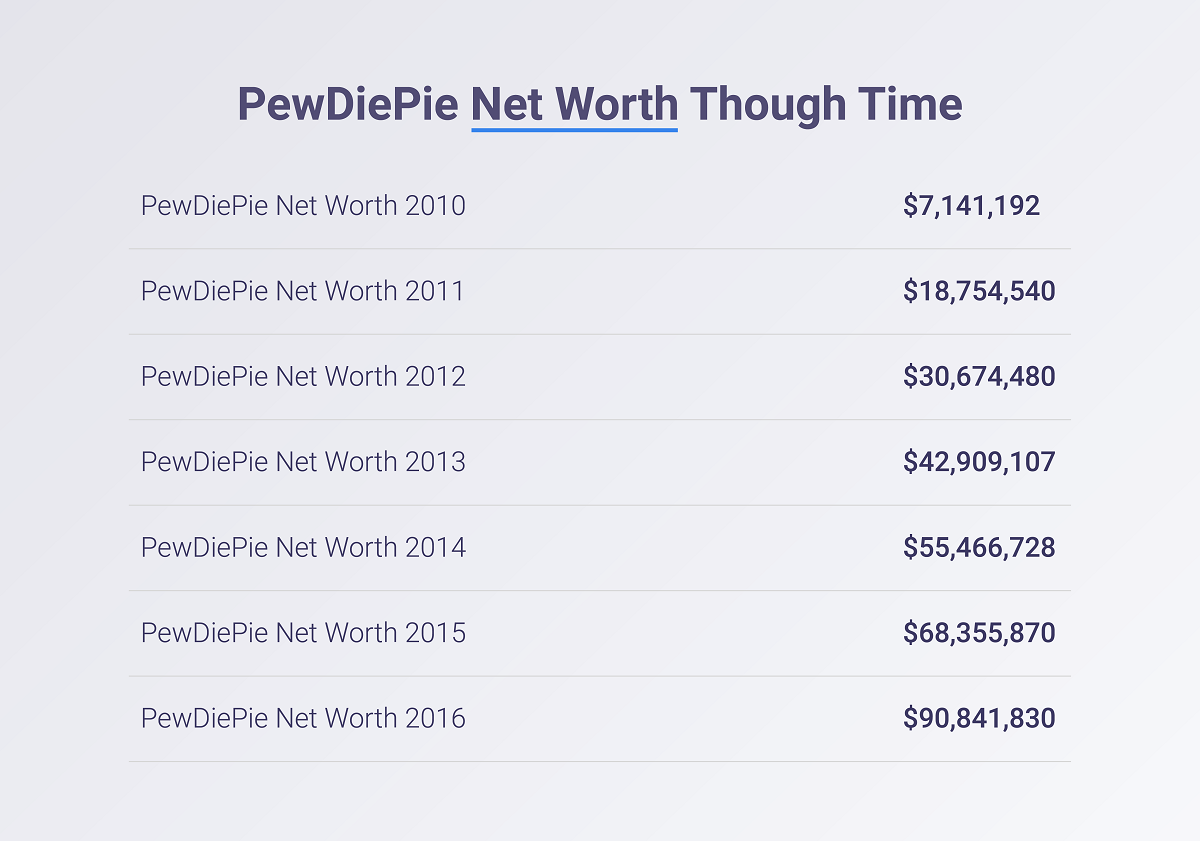
Of course, it’s been well-publicised that Kjellberg’s income took a downward turn after the controversies he was tied-up with in 2017 – but even after losing lucrative deals that ran alongside his YouTube income, he still featured on The Times Young Rich List in 2020 – showing an increase of £6 million in earnings compared to the year before.
PewDiePie is proof that working hard to build a solid brand can lead to unbelievable annual earnings – even if things don’t go to plan 100% of the time.
How else can I make money on YouTube?
While there are plenty of income opportunities that come directly from YouTube – there’s a host of other income streams that most smart YouTubers will be making the most of.
This is where people really hit the big time.
As your audience grows and your content goes from strength to strength, you’re going to naturally attract brands that are keen to work with you.
What that looks can vary enormously. You might find up and coming brands want to send your products to review or just shoot video wearing their products. You could find that people approach you to create products of your own that you can market directly to your subscribers. Then again, you might look at affiliate schemes where you take a chunk of revenue when you hand out discount vouchers or referral codes to the people who watch your content.
There is no end of opportunities for YouTubers with big audiences – and when the time’s right, the Influize team can help you work out how to get sponsored on YouTube and make the most of the opportunities that come your way.
How much can a moderately successful channel expect to earn?
So far, we’ve talked about what super-successful YouTubers can earn – but for every PewDiePie, there’s are thousands of beauty bloggers, travellers, tech fans, and fashion channels (and countless others) making a very respectable annual wage on YouTube.
The key to this kind of income is not relying on a single source of revenue.
So, YouTube ads are working for you? Great – now find 4/5 other sources of income that will prop that up.
Having a business plan to wrap around your channel is the way micro influencers make it on YouTube. If you leave your strategy to YouTube, you’re not going to see your bank account grow in a seriously meaningful way.
This is why it’s vitally important to connect with people who can help you grow. Celebrities, established influencers, brands, and affiliate marketers can all help you monetise your time and efforts.
With 10,000 subscribers, you could be making £200-£300 a month – just creating videos, putting them up, and seeing what YouTube pays out. However, you could easily turn this into £2,000-£3,000 each month if you collaborate with brands, work with celebrities, find affiliate products that work for you – or even create your own products and services.
Taking the first steps toward becoming a YouTuber
Are you ready to start your journey towards YouTube influencer status?
There might not be a huge financial reward immediately – but the sooner you get the foundations in place, the sooner you’ll be able to access the YouTube Partner Program and start building your income from there.
The Influize team can help you take meaningful steps that’ll help you build a targeted social media audience quickly. No fake followers, no ghost followers that don’t engage with your content – just real people who are interested in you, what you do, and the photo and video content you create.
Get in touch – and we’ll help you power your way through the first steps as a YouTuber and grow your audience like never before – and when your audience expands, we’ll help you take full advantage of every money-making opportunity that comes your way.